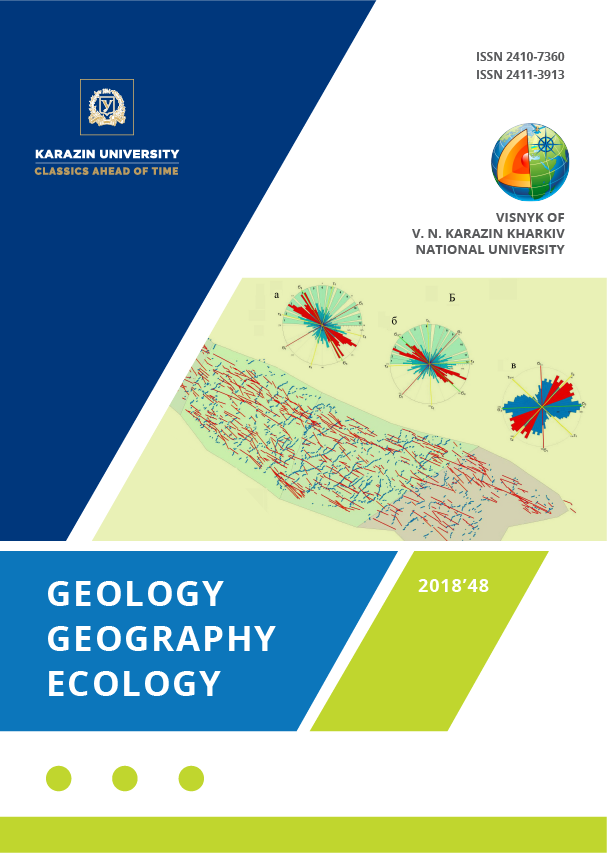Desertification of landscapes in low mountainous and plain sloping foothills of Kur depression
Abstract
As the result of utilization of modern landscapes for various purpose in low mountainous and plain sloping foothills (39.7%) of Kur depression (4036644 hectares) some desertification factors and desertification holes occurred and the danger of degradation of landscapes has increased. In this regard, there is a great need to explore the current state of desertification in the area.
The main objective of the research is to determine the current state of the desertification process, mapping and defining the landscape areas that are subject to desertification in Kur mountainous lowland.
Route-sectoral, comparison, evaluation, statistical interpretation, satellite image decoding methods and ArcGis software were used during the research. Particularly semi-stratified research methods for the determination of desertification indicators, desertification types and desertification rates have played a speci-
al role.
The following key findings were obtained during the research:
- Based on ArcGIS statistical analysis of databases of large scale electronic desalination maps that we have compiled, the areas of desertification of landscapes for the total area and separated physical-geographical regions have been identified and quantitative indicators have been compared.
- 46.1% of the landscape complex of the study area was not affected by desertification in practice. Deserted complexes at various levels make up 53.9% of the total area.
- Geographical distribution of desertification territories in the area depends on the characteristics of natural and anthropogenic desertification factors and the structural-genetic characteristics of landscapes.
- Development of desertification in the region is largely caused by active natural exodynamic processes in semi-desert, dry-steppe, arid-sparse forests and bush.
- In the modern landscape of the study area, sometimes all categories of desertification are observed within a landscape unit.
The scientific achievements of the research.
- For the first time, the area of deserted landscapes has been identified by indicators of desertification in terrain landscapes and factors that led to the formation and development of desertification habitats.
- It was determined that 11.5% of landscapes were slightly, 16.1% moderately and 26.3% severely deserted in the study area.
- NDVI Index based on LANDSAT-8 satellite images (2017) of the area is determined during separation of desertification holes and degradation rates in landscapes.
Practical implications. The results obtained in the research can be used in landscape planning, preparation of meliorative action plans, efficient use of natural resources and implementation of a number of agricultural and environmental projects.
Downloads
References
Aliev, B. G. (2005). The problem of desertification in Azerbaijan and ways to solve it. Ziya-Nurlan, 668.
Askerova, G. G. (2012). Research of phytogeographical peculiarities of desertification of landscapes (on the example of the northeast slope of the Lesser Caucasus and the Jeyranchel lowlands). Science, 184.
Babaev, A. G. (1991). Desertification can be prevented and stopped. Problems of Desert Development, 1, 3-8.
Babaev, A. G. (1986). Deserts. Moscow, Mysyl, 318.
Belgibaev, M. E., Alimbaev, A. K., Minyat, V. E., Smagulov, T. A. (1997). Reaction of Pasture Ecosystems to Desertification. Problems of Desert Development, 5, 3-10.
Budagov, B. A. Garibov, Ya. A., Kulieva, S. Yu. (1997). Anthropogenic foci of desertification in arid geosystems of Azerbaijan. Problems of Desert Development, 3, 22-28.
Budagov, B. A. Mamedov, R. M., Ismatova, X. R., Mikailov, A. A. (2002). Dynamics of Desertification Processes in the Eastern Part of the Republic of Azerbaijan. Proceedings ANAS, 2, 7-16.
Garibov, Ya. A., Yunusov, M. I., Ismailov, M. D., Mamedbejov, E. Sh. (1995). Desertification of the modern landscape of the Kura-Araks lowland. Institute of Geography, 100.
Zolotokrylin, A. N. (2008). Climate and Desertification of the Dry Lands of Russia. Proceedings Russian Academy of Science, 2, 27-35.
Zolotokrylin, A. N. (2003). Climate Desertification. Science, 246.
Zonn, I. S. (1991). War in the Persian Gulf zone and the problem of desertification. Problems of Desert Development, 3-4, 133-144.
Zonn, I. S., Orlovskij, I. S. (1984). Desertification: strategy of struggle. Ylym, 320.
Kovda, V. A. (1984). Problems of combating desertification and salinization of irrigated soils. Kolos, 304.
Kulieva, S. Yu. (1992). Features of desertification of arid geocomplexes of the Nakhichevan Autonomous Republic and measures to combat them. Azerbaijan National Academy of Institute of Geography. Baku, 24.
Museibov, M. A. (2003). Landscapes of the Azerbaijan Republic. Baku University Publishing House, 137.
Olsson, O. L. (2005). Global Desertification: Is Humanity itself the Cause of Desert Formation. Problems of Desert Development, 4, 54-55.
Orlovskij, N. S., Xarin, N. G. (1978). Climate and Desertification. Problems of Desert Development, 3, 33-44.
Petrov, M. P. (1978). Desertification processes in arid regions of Asia and their prevention. Problems of Desert Development, 3, 82-90.
Rozanov, B. G. (1984). Aridization of land and anthropogenic desertification. Pochvovedenie, 12, 34-38.
Tolba, M. K. (1978). Desertification is a common human problem. Problems of Desert Development, 3, 7-16.
Xarin, N. G. (1991). Monitoring and mapping of desertification processes based on materials of Aerosmic imagery. Problems of Desert Development, 3-4, 23-31.





